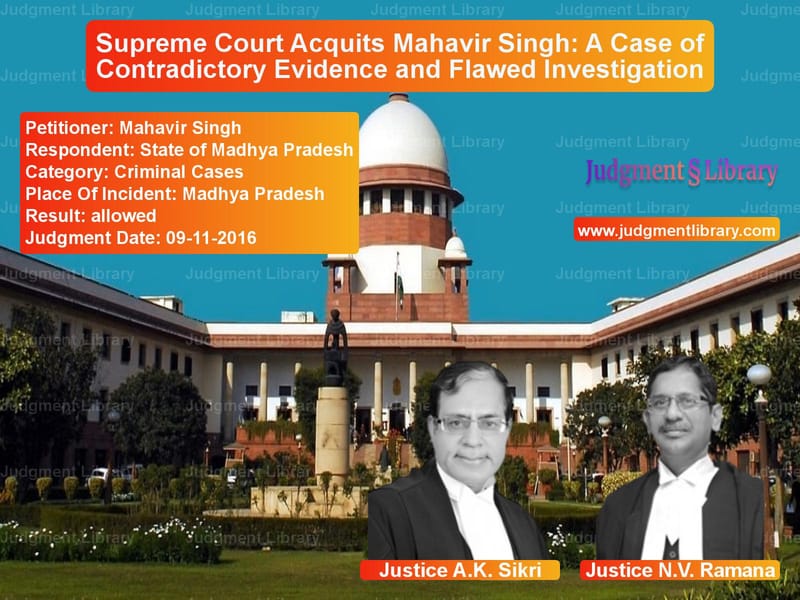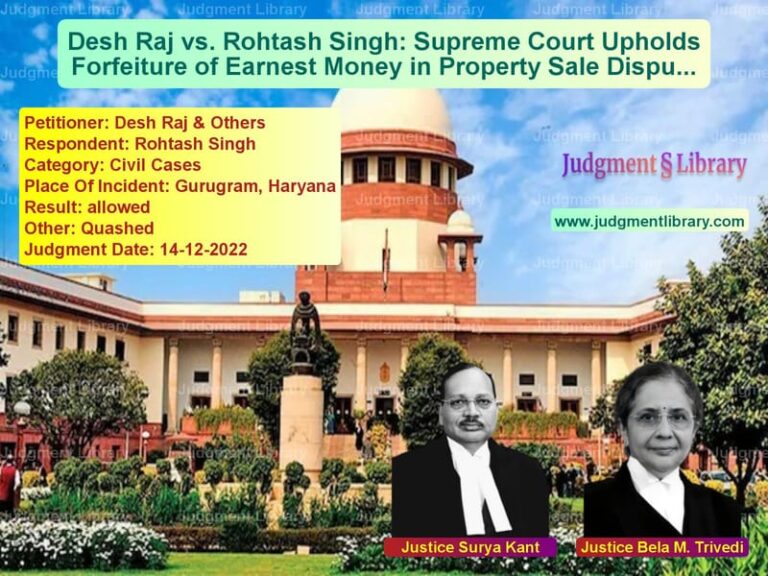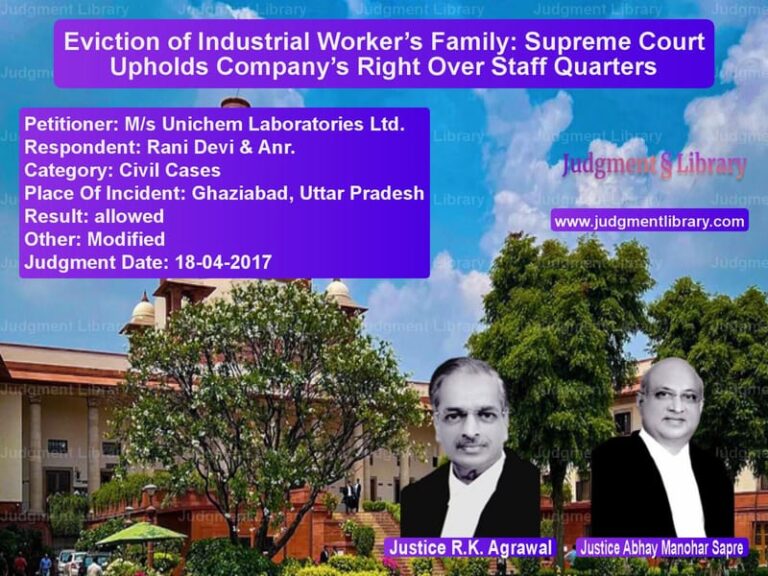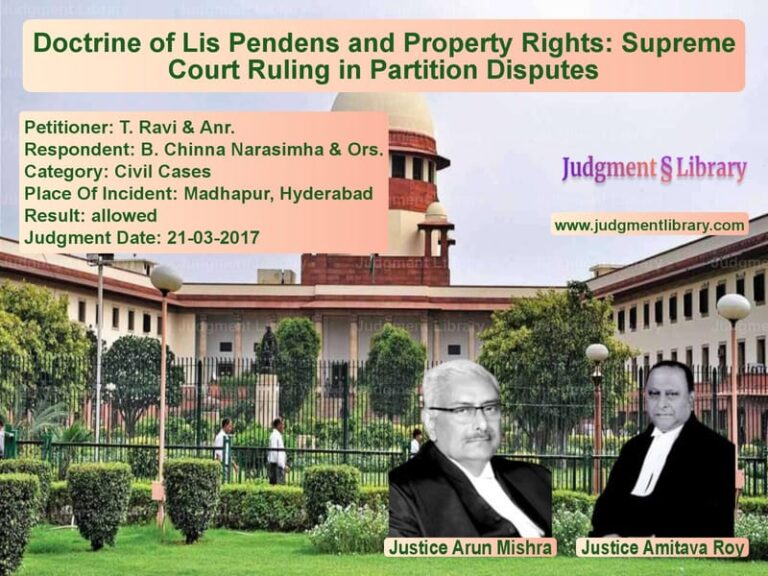Supreme Court Acquits Mahavir Singh: A Case of Contradictory Evidence and Flawed Investigation
The Supreme Court of India, in the case of Mahavir Singh vs. State of Madhya Pradesh, overturned the conviction of the appellant, who had been sentenced to life imprisonment for the murder of Jagannath Singh. The case revolved around a long-standing enmity, eyewitness testimonies, and forensic evidence that failed to conclusively link the accused to the crime.
The Supreme Court, while reaffirming the principles of criminal jurisprudence, emphasized the necessity of proving guilt beyond a reasonable doubt. The judgment exposed significant flaws in the prosecution’s case, including contradictory testimonies, unreliable forensic findings, and a questionable investigation. Consequently, the Court set aside the conviction and acquitted Mahavir Singh.
Background of the Case
The case dates back to December 26, 1987, when Jagannath Singh was allegedly shot dead by Mahavir Singh during a confrontation. According to the prosecution, the accused, along with other co-accused persons, armed with deadly weapons, arrived at the victim’s house, engaged in a verbal altercation, and subsequently shot him in the abdomen. The victim succumbed to his injuries on the spot.
Jagannath Singh’s brother, Gambhir Singh, lodged the First Information Report (FIR) at 4:15 PM on the same day, stating that Mahavir Singh was responsible for the murder. The police seized weapons, including a gun and cartridges, from the accused and sent them for forensic examination.
Key Legal Issues
The Supreme Court examined the following legal issues:
- Whether the prosecution had presented sufficient evidence to prove Mahavir Singh’s guilt beyond a reasonable doubt.
- Whether the medical and forensic evidence corroborated the eyewitness testimonies.
- Whether the High Court was justified in overturning the Trial Court’s acquittal and convicting the appellant.
Petitioner’s Arguments
The defense contended:
- The case was built on circumstantial and contradictory eyewitness testimonies.
- The medical evidence did not conclusively establish that the gunshot wound was inflicted by Mahavir Singh.
- The prosecution’s key witnesses, Gambhir Singh and others, had prior enmity with the accused, raising questions about their credibility.
- The ballistic report failed to establish a direct link between the seized weapon and the fatal gunshot.
- There was an unexplained delay in recording witness statements, further weakening the prosecution’s case.
Respondent’s Arguments
The prosecution argued:
- The accused had a clear motive to kill the victim due to long-standing enmity.
- Eyewitnesses, including family members of the deceased, clearly identified Mahavir Singh as the assailant.
- The forensic examination confirmed that the recovered gun was capable of firing the type of bullet that caused the victim’s death.
- The delay in recording witness statements was procedural and did not impact the credibility of the evidence.
Supreme Court’s Observations
The Supreme Court critically analyzed the evidence and found several inconsistencies in the prosecution’s case. The key observations included:
1. Contradictions in Eyewitness Testimonies
The Court noted that different witnesses gave conflicting accounts regarding the sequence of events. While some stated that the victim was shot while sitting on a platform, others claimed he was standing. The height difference between the accused and the victim was also not established, making it unclear whether the gunshot trajectory was consistent with the prosecution’s claim.
2. Questionable Forensic Evidence
The forensic report did not conclusively establish that the fatal bullet was fired from Mahavir Singh’s gun. The lack of direct ballistic confirmation created reasonable doubt about the accused’s involvement.
3. Delay in Witness Statements
The Court observed that key witness statements were recorded much later, raising concerns about possible fabrication. Delayed testimonies, especially in cases involving prior enmity, are viewed with caution.
4. Failure to Prove Guilt Beyond Reasonable Doubt
The Supreme Court reiterated that criminal cases must be proven beyond a reasonable doubt. The gaps in the prosecution’s case, combined with unreliable witness statements and weak forensic links, did not meet this standard.
Final Judgment
The Supreme Court ruled in favor of the appellant, setting aside his conviction and ordering his immediate release. The key takeaways from the judgment were:
- The prosecution failed to establish guilt beyond a reasonable doubt.
- The High Court’s decision to overturn the Trial Court’s acquittal was unjustified.
- The accused was entitled to the benefit of doubt.
Judgment Outcome: Appeal allowed, conviction overturned, appellant acquitted.
Don’t miss out on the full details! Download the complete judgment in PDF format below and gain valuable insights instantly!
Download Judgment: Mahavir Singh vs State of Madhya Prad Supreme Court of India Judgment Dated 09-11-2016.pdf
Direct Downlaod Judgment: Direct downlaod this Judgment
See all petitions in Murder Cases
See all petitions in Bail and Anticipatory Bail
See all petitions in Attempt to Murder Cases
See all petitions in Judgment by A.K. Sikri
See all petitions in Judgment by N.V. Ramana
See all petitions in allowed
See all petitions in supreme court of India judgments November 2016
See all petitions in 2016 judgments
See all posts in Criminal Cases Category
See all allowed petitions in Criminal Cases Category
See all Dismissed petitions in Criminal Cases Category
See all partially allowed petitions in Criminal Cases Category







